The NVIDIA SHIELD Tablet Review
by Joshua Ho on July 29, 2014 9:00 AM EST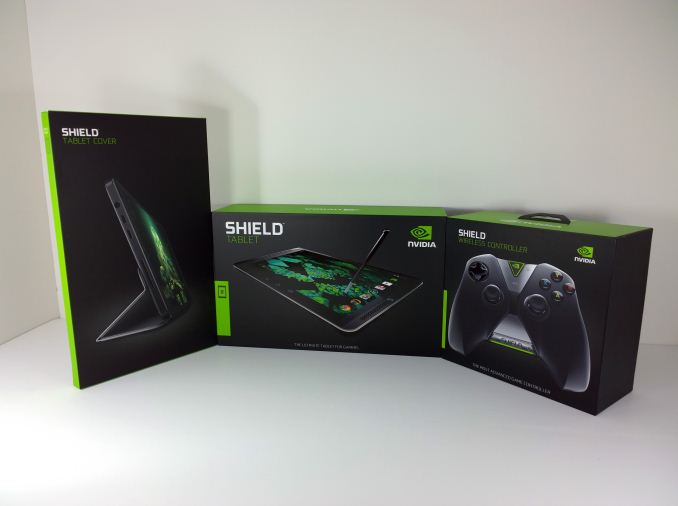
As I discussed in our launch article last week, the Shield tablet is very much the culmination of lessons learned from 2013. While the Tegra Note 7 was a decent tablet, it had to eke out a profit through hardware sales against competition that was willing to sell their tablets with no profit on hardware. Meanwhile the Shield portable was a good portable gaming device, but it was far too specialized to be anything but a gaming device. Without an established gaming ecosystem, NVIDIA struggled against established competitors.
As a result of these influences, today NVIDIA is becoming the first OEM to launch a serious gaming tablet running Android. While gaming tablets have been done before, they’ve been few and far between. Now it has always been technically possible to take a high end tablet and make it usable for gaming, but for the most part these attempts are marred by either the need for root or an application that requires extensive work on the part of the user to create proper control profiles for each game. In addition, the SoC in the tablet is often underequipped for intensive 3D gaming.
That’s where the Shield tablet comes in. With Tegra K1, a dedicated controller, 2x2 WiFi, and a huge amount of custom software, there’s definitely a lot of ground to cover. Once again, while the Shield tablet is a gaming device, it must also be a good tablet. To that end, NVIDIA has tried to differentiate this tablet with DirectStylus 2 and dual front facing speakers/bass reflex ports. I’ve included a table of specifications below to give a general idea of what the tablet is like.
| NVIDIA Shield Tablet | |
| SoC | Tegra K1 (2.2 GHz 4x Cortex A15r3, Kepler 1 SMX GPU) |
| RAM/NAND | 2 GB DDR3L-1866, 16/32GB NAND + microSD |
| Display | 8” 1920x1200 IPS LCD |
| Network | N/A or 2G / 3G / 4G LTE (NVIDIA Icera i500 UE Category 3/4 LTE) |
| Dimensions | 221 x 126 x 9.2mm, 390 grams |
| Camera | 5MP rear camera, 1.4 µm pixels, 1/4" CMOS size. 5MP FFC |
| Battery | 5197 mAh, 3.8V chemistry (19.75 Whr) |
| OS | Android 4.4.2 |
| Connectivity | 2x2 802.11a/b/g/n + BT 4.0, USB2.0, GPS/GLONASS, mini HDMI 1.4a |
| SIM Size | None or MicroSIM |
| Price | $299 or $399 (16GB/WiFi or 32GB/LTE) + $59 (optional controller) |
Hardware
Outside of the basic specs, the tablet itself has a much more subtle industrial and material design. While the large speaker grilles are maintained from the Tegra Note 7, the dimpled look and feel is gone. Instead, the finish is very much reminiscent of the Nexus 5. The feel isn’t quite rubbery the way soft touch finishes tend to be. Instead, it feels more like a high grain matte polycarbonate. Along the sides, there’s a noticeable chamfered edge where the back cover meets the display, although in practice this mostly affects aesthetics rather than in hand feel. The flip cover that is designed for the device is almost identical to the one in the Tegra Note 7, and folds up similarly. As with the Tegra Note 7, there are two angles that the flip cover can take. Overall, the aesthetic is much more subtle than the Tegra Note 7, and looks quite similar to the Nexus 7 (2013).
While it’s important for the tablet portion of the device to have decent material and industrial design, ergonomics and material design are critical for the controller. While the Shield portable had great ergonomics, it was heavy because the entire device had to fit in the controller. With Shield Tablet, that’s no longer the case. The result is that the controller is significantly lighter. While it still has some heft to it, I no longer feel the need to rest my hands against a table after significant playtime.
The controller itself is just as good as the one on the Shield Portable. The buttons, triggers, bumpers, and joysticks are all very close in feel. The one big difference are the tablet/Android controls. Instead of physical buttons, they’ve replaced the physical buttons with capacitive ones. The volume controls have also been moved down to the bottom of the controller and changed from a single button that triggers on-display volume controls to a rocker that allows direct manipulation of volume. Just above the volume rocker is a clickpad, which can be used to move a cursor through the UI. While this option exists, it’s a bit unpolished as the sensitivity isn’t tuned quite right to quickly navigate through the tablet.
Of course, there’s more to the controller than just the buttons and controls. NVIDIA has made sure to do things right by using WiFi Direct for communicating between the controller and the tablet. The frequency used depends upon what access point the tablet is connected to, so it can switch between 2.4 GHz and 5 GHz as necessary. NVIDIA claims that using WiFi Direct instead of Bluetooth drops latency by half, and also allows for microphone input and sound output via 3.5mm jack through the controller. In practice, the controller works great. I don’t have any complaints about this at all. Pairing is as simple as pressing and holding on the NVIDIA logo for a few seconds, then opening the pairing application. Up to four controllers can be paired to the tablet this way, which introduces interesting possibilities for local multiplayer games such as Trine 2. I also didn’t notice a difference in response time of the wireless controller when compared to the wired controller of Shield Portable. It’s incredibly important to get the controller right for gaming devices, and NVIDIA has nailed it. Overall, I’m happy with the basic hardware for both the controller and tablet. While it would be interesting to see a metal unibody design on the tablet, it’s difficult to justify at the price point that this device has to hit.
Of course, while hardware is important, software makes or breaks this tablet, so that’s next.


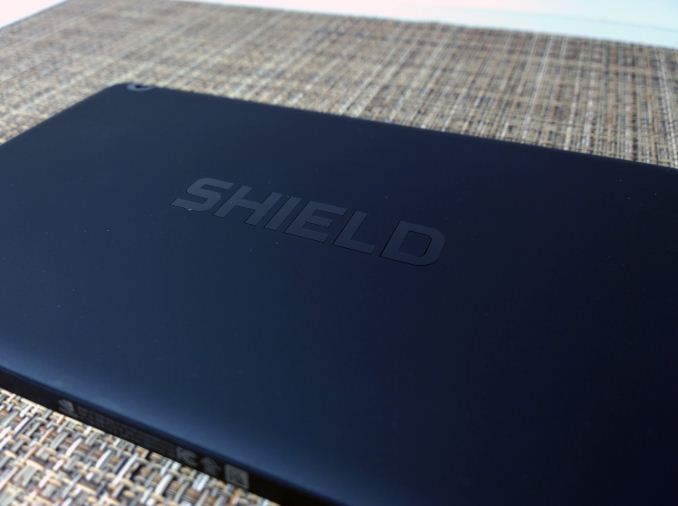
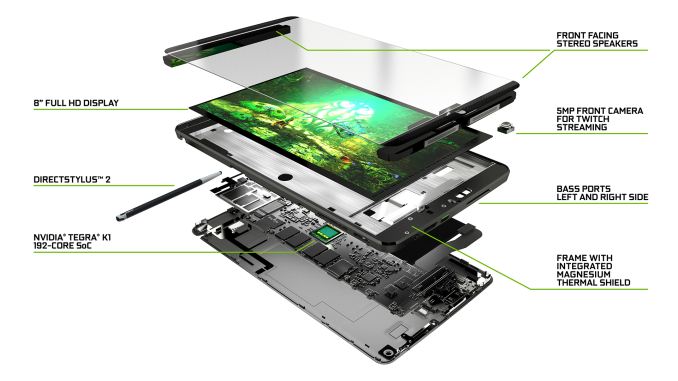
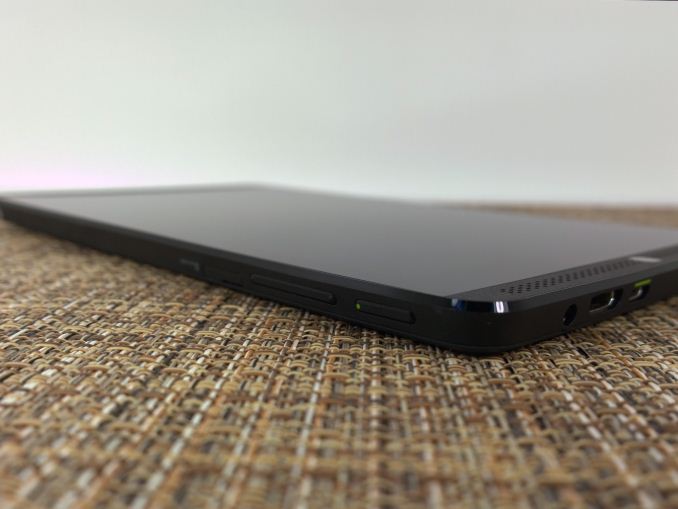
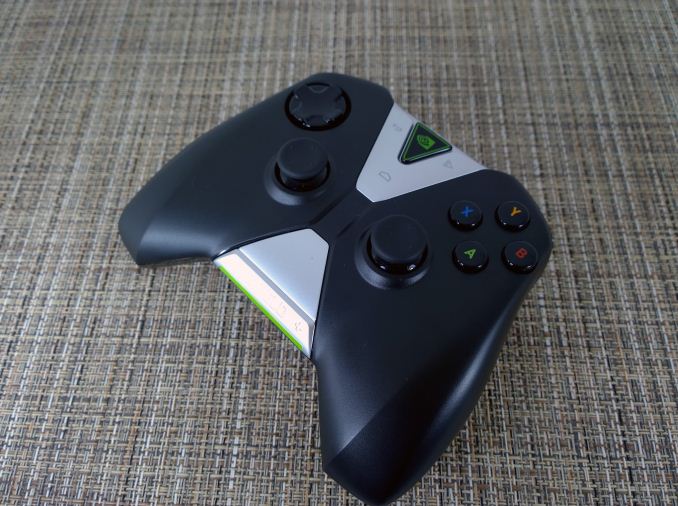








174 Comments
View All Comments
SpartyOn - Tuesday, July 29, 2014 - link
I guess it depends on your setup or what steps you're willing to take. I have an Asus Z77 wifi mobo so I use the Asus Wifi Go app a lot, which allows me remote desktop access and mirroring in an easy package. Haven't invested in a Bluetooth mouse or keyboard, but using USB OTG has worked out just fine for times I've hooked the Shield up to a monitor with M&K.I've done some video editing in Adobe Premiere remotely this way, along with working with Excel files, so I'd say it can actually do work just fine. Does it require some additional cables/accessories to maximize that professional potential? Sure, but then again, I'm not going to be doing any serious work on an 8" Shield tablet without hooking it up to a monitor as well.
fivefeet8 - Tuesday, July 29, 2014 - link
Much of the activities I do require me to be away from the home so a shield with a gamepad attached to the screen would be a bit awkward. The tablet fits more with my requirements.SpartyOn - Tuesday, July 29, 2014 - link
I think there's room for both devices for those that buy into the Nvidia brand and who understand/utilize the gaming features; however, the tablet space is a very competitive market for Nvidia to try and enter, with numerous players, especially for work and professional devices.An additional thought on the gaming side, since this really is the target audience: Does it pass the eye test? If I'm a gamer, and I see someone with a 1st gen Shield, I immediately know that it's a gaming device and might inquire what it is. I also can look at pics when shopping and know that it's a gaming device. If I see someone using the 2nd gen Shield, I just see another tablet out in the wild and when shopping online, it would have to come down to specs/features comparisons.
I guess the overall point I'm trying to make is this: the original Shield was so insanely different that over time it had a chance to succeed, especially with yearly refreshes. Now it's just another tablet that can't even stand up on its own (literally and figuratively) ... how do I balance a tablet in bed or on the couch (or in a plane, train, car?!) when I have to fiddle with a controller and the screen itself. Seems cumbersome for gaming to me and in my opinion actually makes you MORE tethered to a stationary external monitor/HDTV instead of the handheld.
fivefeet8 - Tuesday, July 29, 2014 - link
If there is enough demand for another Shield1 type device, then you may yet see it, but from what's been gathered, there wasn't. Although I do find it also an interesting device, the gamepad agnostic nature of the Tablet gives a better experience with 3rd party pads. Some of which are attachable albeit a bit weight slanted. And it gives console mode an advantage of not having to use another controller.aamir147 - Tuesday, July 29, 2014 - link
I believe the tablet is just another addition to the shield family, this is not to replace the shield portable. This is what the mod in the nvidia blog said.savagemike - Tuesday, July 29, 2014 - link
It would be trivial to make a frame to hold the tablet and controller together for use as you'd like. Meanwhile I was never attracted to the first Shield because gaming is not my number 1 interest - just something that would be a nice bonus.What I'm saying is this more modular approach could easily be made to work as the original Shield but the original Shield cannot be made to work as a stand-alone tablet. So for me this is a much better design.
Especially with the advent of 3d printing. It will only take one clever person to design something to hold the tablet and controller together to mimic the original. If you don't see it pop up soon for easy purchase then it isn't that wanted as it would be simple to do.
Knowname - Wednesday, July 30, 2014 - link
I think you should consider the directstylus modes. I'm sure the wife (if the tablet isn't too heavy) would love that. lus she could read and do other tablet stuffs... if she can get around the horribly dull screen ofc.schizoide - Tuesday, July 29, 2014 - link
You can pick up a refurb Nexus 7 (2013) for $140 from an authorized seller on eBay, or $230 full price and new. The shield tablet costs $300. What do you get for twice the money?From a tablet perspective:
- Slightly larger, but lower quality screen
- Stylus
- Dramatically improved speakers
- 28% heavier
- Maybe slightly snappier? Much faster in benchmarks, but the Nexus 7 2013 is fine for browsing and tablet stuff. I haven't seen anyone compare them in interactive use.
From a gaming perspective:
- Shadowplay, if you have a nVidia GPU in your gaming box and want to plug a tablet into your TV. Better off getting a haswell chromebox and installing steam for linux on it.
- Grid streaming, if you're in northern california.
- A couple Tegrazone games, primarily 10 year old PC ports.
- All the android games built for the lowest common denominator that play on your Aunt's Galaxy S2 will play here too.
In my opinion, the Shield tablet doesn't make a lot of sense as a tablet or as a gaming device. If it was priced competitively with the new Nexus 7, then certainly it would be interesting. If you want to buy a small android tablet and don't care about the $70 (or $160 for the refurb!) I guess go crazy. But will they sell a lot of them? No way.
Now if nVidia could get something like their GTX 860M and crunch it down to fit in a tablet TDP, and slotted it in alongside an atom CPU for a tablet running real Windows, with its massive software library, that could be truly attractive.
ams23 - Tuesday, July 29, 2014 - link
Shield tablet is already #5 in the Amazon.com best sellers list for tablets: http://www.amazon.com/Best-Sellers-Electronics-Com...Nexus 7 is a great tablet too, but the difference in SoC performance is quite large. Shield tablet has 2x higher CPU performance and 3x higher GPU performance in comparison, with a much more modern GPU too.
Note that many of the people getting the Shield tablet are upgrading from the original Nexus 7 tablet, so the difference for these people will be like night and day.
schizoide - Tuesday, July 29, 2014 - link
Yeah, it's beating the ipad air and mini. It just came out. You think that'll hold up?